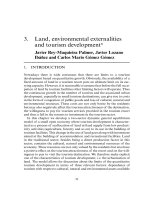THE ECONOMICS OF MONEY,BANKING, AND FINANCIAL MARKETS 457
Bạn đang xem bản rút gọn của tài liệu. Xem và tải ngay bản đầy đủ của tài liệu tại đây (51.45 KB, 1 trang )
CHAPTER 16
A PP LI CATI O N
The Money Supply Process
425
The Great Depression Bank Panics, 1930 1933
We can also use our money supply model to help us understand major movements
in the money supply that have occurred in the past. In this application, we use the
model to explain the monetary contraction that occurred in the United States during the Great Depression. In Chapter 9 we discussed bank panics and saw that they
could harm the economy by making asymmetric information problems more severe
in credit markets, as they did during the Great Depression. Here we can see that
another consequence of bank panics is that they can cause a substantial reduction
in the money supply. As we will see in the chapters on monetary theory later in the
book, such reductions can also cause severe damage to the economy.
Figure 16-1 traces the bank crisis during the Great Depression by showing the
volume of deposits at failed commercial banks from 1929 to 1933. In their classic
book A Monetary History of the United States, 1867 1960, Milton Friedman and
Anna Schwartz describe the onset of the first banking crisis in late 1930 as follows:
Before October 1930, deposits of suspended [failed] commercial banks had been
somewhat higher than during most of 1929 but not out of line with experience during the preceding decade. In November 1930, they were more than double the highest value recorded since the start of monthly data in 1921. A crop of bank failures,
particularly in Missouri, Indiana, Illinois, Iowa, Arkansas, and North Carolina, led to
widespread attempts to convert chequable and time deposits into currency, and
also, to a much lesser extent, into postal savings deposits. A contagion of fear
Deposits
(US$ millions)
500
400
300
200
100
Start of First
Banking
Crisis
End of Final
Banking
Crisis
50
40
30
20
10
0
1929
F I G U R E 16 - 1
1930
1931
1932
1933
Deposits of Failed Commercial Banks, 1929 1933
Source: Milton Friedman and Anna Jacobson Schwartz, A Monetary History of the United States,
1867 1960 (Princeton, N.J.: Princeton University Press, 1963), p. 309.









